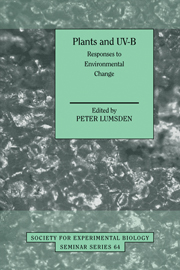Book contents
- Frontmatter
- Contents
- List of contributors
- Preface
- PART I The ozone layer and UV-B radiation
- PART II Effects of UV-B on plants at the cellular level
- PART III Effects of UV-B at the whole plant and community level
- Effects of solar UV-B radiation on aquatic ecosystems
- Assessing the impact of UV-B radiation on the growth and yield of field crops
- Effects of UV-B radiation on plants from agro- and natural ecosystems
- Effects on subarctic vegetation of enhanced UV-B radiation
- Impacts of elevated UV-B on forest ecosystems
- Effects of elevated UV-B radiation and elevated CO2 on heathland communities
- Alterations in competitive balance
- Interations between trophic levels
- Index
Impacts of elevated UV-B on forest ecosystems
Published online by Cambridge University Press: 04 August 2010
- Frontmatter
- Contents
- List of contributors
- Preface
- PART I The ozone layer and UV-B radiation
- PART II Effects of UV-B on plants at the cellular level
- PART III Effects of UV-B at the whole plant and community level
- Effects of solar UV-B radiation on aquatic ecosystems
- Assessing the impact of UV-B radiation on the growth and yield of field crops
- Effects of UV-B radiation on plants from agro- and natural ecosystems
- Effects on subarctic vegetation of enhanced UV-B radiation
- Impacts of elevated UV-B on forest ecosystems
- Effects of elevated UV-B radiation and elevated CO2 on heathland communities
- Alterations in competitive balance
- Interations between trophic levels
- Index
Summary
Introduction
Increases in solar UV-B (ultraviolet-B radiation, here taken as 280–315 nm) are expected to result from stratospheric ozone depletion (Blumthaler & Ambach, 1990; Kerr & McElroy, 1993; see also chapter by Webb, this volume). Consequently, a wide range of experimental studies have been undertaken to assess the impact of increases in UV-B on vegetation (Caldwell et al, 1995). Many early studies were conducted in controlled environment chambers and greenhouses in which plants were exposed to supplemental levels of UV radiation from fluorescent lamps. More recently, field studies with supplemental UV-B radiation have also been undertaken. Initially these simply turned lamps on and off at a constant irradiance to give so-called ‘square-wave’ treatments (Sullivan et al, 1994a), but increasingly, lamp irradiances have been modulated to maintain a proportional elevation above ambient UV-B (McLeod, 1997). The majority of studies have examined crop species, but trees, perhaps because of their size and vertical distribution of foliage, have been the subject of few investigations, even though they play a central role in the global carbon cycle. Of the 550 Gt carbon in the land biota, 65% is in forests and of the 1550 Gt carbon in soils and detritus, 50% is in forest soils (Cannell, 1995). Studies of the many interactions that occur between different trophic levels in an ecosystem and their role in decomposition and nutrient cycling have only been investigated in dwarf shrubs of the subarctic (Gehrke et al, 1995), and studies of forest ecosystems have only recently begun (Newsham et al, 1996).
- Type
- Chapter
- Information
- Plants and UV-BResponses to Environmental Change, pp. 247 - 282Publisher: Cambridge University PressPrint publication year: 1997
- 8
- Cited by

